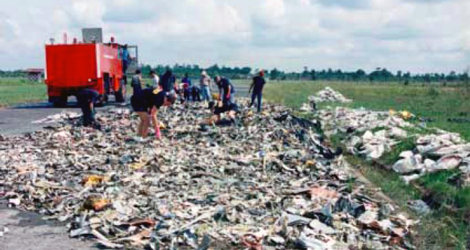Silkair flight MI185 took off at 08:37:13 (15:37:13 local time) from Runway 25R with the Captain as the handling pilot.
The flight received clearance to climb to 35,000 feet (Flight Level 350) and to head directly to Palembang.
At 08:47:23 the aircraft passed FL245. Ten seconds later, the crew requested permission to proceed directly to PARDI.
The air traffic controller instructed flight MI185 to standby, to continue flying directly to Palembang and to report when reaching FL350.
At 08:53:17, Silkair flight MI185 reported reaching FL350. Subsequently, the controller cleared MI 185 to proceed directly to PARDI and to report when abeam Palembang.
At 09:05:15.6, the cockpit voice recorder (CVR) ceased recording.
Analysis of the CVR stoppage indicated that the failure of the CVR could not have been caused by a short circuit or overload.
According to the Jakarta ATC transcript, at 09:10:18 the controller informed Silkair flight MI185 that it was abeam Palembang. The controller instructed the aircraft to maintain FL350 and to contact Singapore Control when at PARDI.
The crew acknowledged this call at 09:10:26.
There were no further voice transmissions from Silkair flight MI185.
The last readable data from the flight data recorder (FDR) was at 09:11:27.4. Jakarta ATC radar recording showed that Silkair flight MI185 was still at FL350 at 09:12:09.
The next radar return, eight seconds later, indicated that Silkair flight MI185 was 400 feet below FL350 and a rapid descent followed. The last recorded radar data at 09:12:41 showed the aircraft at FL195. The empennage of the aircraft subsequently broke up in flight and the aircraft crashed into the Musi river delta, about 50 kilometres (30 nautical miles) north-north-east of Palembang at about 09:13. The accident occurred in daylight and in good weather conditions.
Following are a few evidences taken from the report : the final conclusion is that “the technical investigation has yielded no evidence to explain the cause of the accident.“
- There was no evidence found of in-flight fire or explosion.
- From flutter analysis and wreckage distribution study, the empennage break-up could have occurred in the range between 5,000 and 12,000 feet altitude.
- The engines were considered to be not a factor contributing to the accident.
- Examination of the 370 kg of recovered electrical wires, connectors and circuit boards showed no indication or evidence of corrosion, shorting, burning or arcing in these wires or parts.
- The CVR stopped recording at 09:05:15.6 and the FDR stopped recording at 09:11:33.7.
The examination of the CVR and FDR showed no malfunction of the units. The stoppages could be attributed to a loss of power supply to the units. However, there were no indications or evidence found to conclude on the reason for the stoppages due to the loss of power. The cause of the CVR and FDR stoppages and the reason for the time difference between the stoppages could not be concluded. - Weather and Air Traffic Control were not factors contributing to the accident.
- The examination of the flight deck noise and sounds concludes that the metallic snap recorded on the CVR was made by a seatbelt buckle hitting against a metal surface.
- Interviews with respective superiors, colleagues, friends and family revealed no evidence that both the flight crew members had changed their normal behaviour prior to the accident.
- There was no evidence found to indicate that there were any difficulties in the relationship between the two pilots either during or before the accident flight; or had been experiencing noteworthy difficulties in any personal relationships (family and friends).
- Until the stoppage of the CVR, the pilots conducted the flight in a normal manner and conformed to all requirements and standard operating procedures.
- Although a flight attendant had been in the cockpit previously, after the last meal service and until the stoppage of the CVR there was no indication that anyone else was in the cockpit other than the two pilots.
- In the final seconds of the CVR recording the PIC voiced his intention to leave the flight deck, however there were no indications or evidence that he had left.
- Interviews and records showed that in 1997 the PIC had experienced a number of flight operations related events, one of which resulted in his being relieved of his LIP position.
- The PIC was involved in stock-trading activities, but no conclusions could be made indicating that these activities had influenced his performance as a pilot.
- From the data available to the NTSC there was no evidence found to indicate if the mortgage policy taken out by the PIC in connection with his housing loan has any relevance to the accident.


The crash was not 12/12/1997 but Friday 19/12/1997
(Australian time)
corrected, thank you BROUWERS.